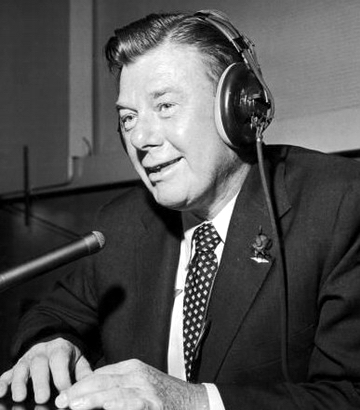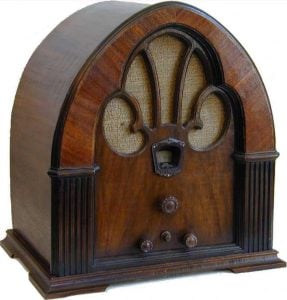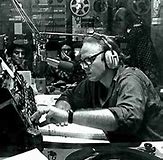The Podcast Revolution: The Power of Our Human Voice, from Marconi to Woods Hole

Heard “Trader Joe’s” podcast yet? I don’t know who might listen to a 22-minute corporate ad. But, given how cool podcasts have become: hey, that sounds inviting. The idea is also an implicit endorsement for radio — because that’s where podcasting originated. Yes.
I don’t want to disenchant young progressives for whom podcasts are their go-to listening medium today. It likely wouldn’t concern them in any case that in fact these phone-friendly popular audio items are little more than archived radio productions. They follow basic principles developed by radio hosts and editors over the years — many years.
I’m not here to knock podcasting; not at all; podcasts are a welcome advance, a real boon for radio broadcasting. Still evolving, radio has conscripted a generation who twenty-five years ago listened to sound productions only in a car, or (as teenagers) from a boom box at the beach.
Today’s listeners don’t dial into 99.5 FM or 8:00 AM. Through iTunes or another app, they locate an amusing podcast among a list of hundreds (thousands?) of podcast subjects or sites. Many of those are original radio productions adapted to a podcast format, packaged into serials that can be subscribed to, listened to, stopped, then picked up later. Everything’s portable—not only in your car, but in your pocket phone while traveling to work by train or subway car.
So the medium of radio not only survives; it’s evolving too, using the latest technology to reach into every phone.
How has radio’s appeal endured? Simply because radio builds on its quintessential feature — intimacy. Besides its proven versatility, radio invites us in. Yes, it may stimulate us with flute solos, sitar ragas, blues and R&B, Brahms sonatas or inventive hip-hop poetry. More poignantly, radio taps our deep human need for the voices of others. It’s often a very private experience, affirmed by the ubiquity of slinky earbuds and chunky wireless headphones that envelope each wearer in his and her personal world.
You may be unfamiliar with a piece of household furniture known as an FM radio receiver — like Jackson Bell 1930s ‘cathedral’ style countertop item. But you’ll find classics such as Bakelite radios and transistors on vintage radio sites for broadcasting aficionados from the era bypassed by the current generation — like the dial-up phone that had to be plugged into a wall!
Image on the right: Cathedral Model Radio 1830
I learned about the dispensability of these FM home receivers when visiting the apartment of a fellow producer thirteen years ago. She quietly answered my challenge — How can a radio producer not possess a radio, the medium we work in? — by opening her computer and tuning into our station’s webpage! “It’s called streaming”, she informed this old-timer.
Today every station live-streams and offers a phone app through which you can subscribe to listen live and search archived shows and podcasts. Thanks to phone apps radio’s reach extends far beyond the kitchen table model or the car receiver. (For a few intervening years when television dominated home entertainment, the car was where most radio programs reached listeners. Then cars acquired SiriusXM (launching 22 podcasts soon, I’m informed) whose plethora of channels competes with television.
Sixty years ago, apart from the toaster, a radio was the only electronic device in regular use in a home. When television came along, oh the woes and warnings: radio was finished. How would it complete with live picture transmissions? Chatty comedians like Arthur Godfrey eschewed radio for TV, as did sportscasters. (Imagine fans gathering around a sitting room audio receiver cheering on their team! But they did.) Then there’s drama; drama was once a mainstay of radio, offering employment for writers, actors and sound effects specialists. “The Lone Ranger” and “The Shadow” were two serialized shows I recall hearing as a child. (One can still find those early dramas on programs like “The Golden Age of Radio” which my WBAI colleague Max Schmid began producing in 1976.)
Radio dramas provided evening family entertainment and were adapted for children too. I belong to the generation of schoolchildren who walked home for lunch where we heard a daily episode of some short children’s drama airing at 12:30. This was in Canada where radio always had a special status. (Maybe it still does.)
The still popular broadcast “Selected Shorts” based on recorded performances began in 1985. Today radio drama is enlivened by productions like “The Moth Radio Hour” launched in 2010 (from Woods Hole, MA) inspired by Atlantic Media’s commitment to “the art of the story, in the power of sound and spoken word”. (Atlantic Media introduced a fresh ambiance into radio broadcasting.)
For decades after television was a household fixture, in defiance of expectations, radio held his own. Television sets were initially one per household, dominating the sitting room, with the radio receiver consigned to the kitchen for morning news and weather.
Radio’s role in the music industry was advanced by American Top 40 Countdown introduced in 1970 by Casey Kassem.
Image below: Radio Unnamable’s Bob Fass
And what about political radio? Perhaps as a corollary to growing opposition to the Vietnam War, alternative voices carved out their space on the FM dial. The Pacifica Network (founded in 1949 surged in popularity during the 1960s (which in 1996 gave birth to Democracy Now which largely eclipsed the mother network). Pacifica’s early commitment to vigorous debate and a space for dissenting voices fostered the talk-radio format where lively hosts brought listeners on-air by phone. Talk radio’s widening influence is now associated with extreme conservative advocates Rush Limbaugh, MichaelSavage and Mark Levin. Their radical views may appear risible to some and frightening to others, but their deep impact into American politics is unarguable. One of the founders of talk-radio lies at the other end of the political spectrum — Radio Unnamable’s Bob Fass who originated free-form radio which also revolutionized late night FM listening.
The Podcast revolution notwithstanding, regular FM broadcasting is attracting print news sources to the air, from “Counterpunch” to “The New Yorker Radio” and New York Times’ “The Daily”.
Stay tuned for more.
*
Note to readers: please click the share buttons above or below. Forward this article to your email lists. Crosspost on your blog site, internet forums. etc.
Barbara Nimri Aziz is a New York based anthropologist and journalist. In addition to books on Tibet and Nepal, she is author of “Swimming Up the Tigris: Real Life Encounters with Iraq” based on her work in Iraq and the Arab Homelands. For many years a producer at Pacifica-WBAI Radio in NY, her productions and current articles can be found at www.RadioTahrir.org
Featured image: Radio Host Arthur Godfrey; all images in this article are from the author



